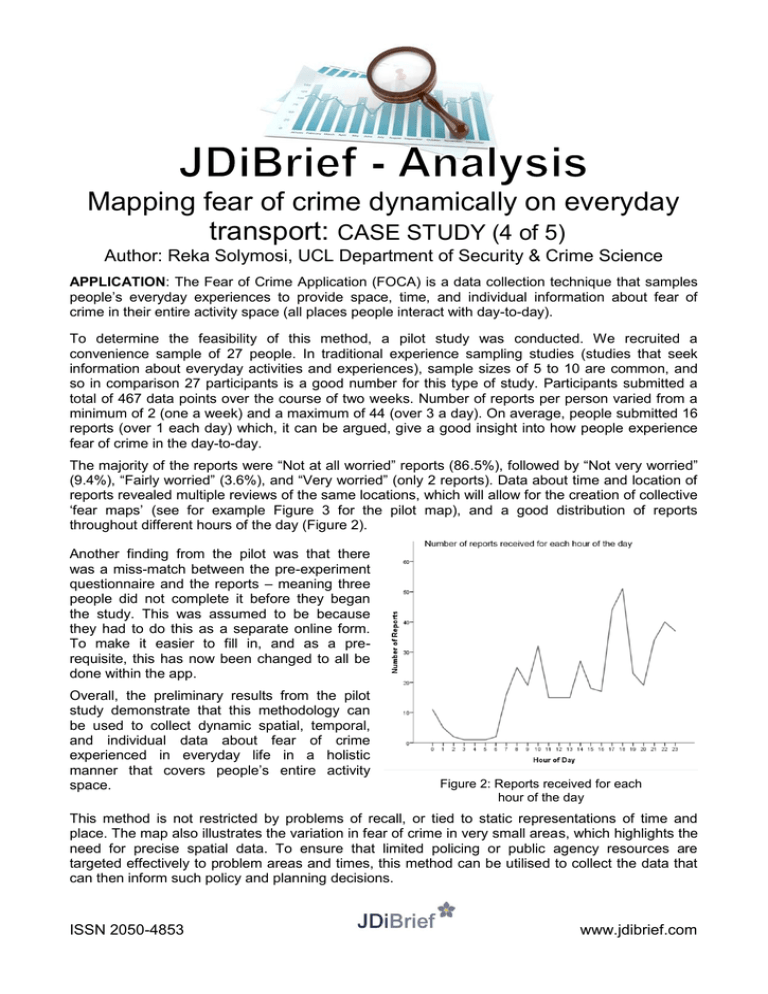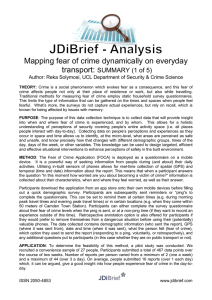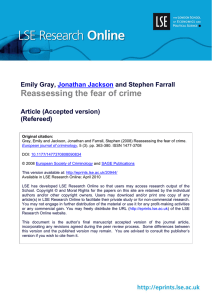Mapping fear of crime dynamically on everyday transport:
advertisement

Mapping fear of crime dynamically on everyday transport: CASE STUDY (4 of 5) Author: Reka Solymosi, UCL Department of Security & Crime Science APPLICATION: The Fear of Crime Application (FOCA) is a data collection technique that samples people’s everyday experiences to provide space, time, and individual information about fear of crime in their entire activity space (all places people interact with day-to-day). To determine the feasibility of this method, a pilot study was conducted. We recruited a convenience sample of 27 people. In traditional experience sampling studies (studies that seek information about everyday activities and experiences), sample sizes of 5 to 10 are common, and so in comparison 27 participants is a good number for this type of study. Participants submitted a total of 467 data points over the course of two weeks. Number of reports per person varied from a minimum of 2 (one a week) and a maximum of 44 (over 3 a day). On average, people submitted 16 reports (over 1 each day) which, it can be argued, give a good insight into how people experience fear of crime in the day-to-day. The majority of the reports were “Not at all worried” reports (86.5%), followed by “Not very worried” (9.4%), “Fairly worried” (3.6%), and “Very worried” (only 2 reports). Data about time and location of reports revealed multiple reviews of the same locations, which will allow for the creation of collective ‘fear maps’ (see for example Figure 3 for the pilot map), and a good distribution of reports throughout different hours of the day (Figure 2). Another finding from the pilot was that there was a miss-match between the pre-experiment questionnaire and the reports – meaning three people did not complete it before they began the study. This was assumed to be because they had to do this as a separate online form. To make it easier to fill in, and as a prerequisite, this has now been changed to all be done within the app. Overall, the preliminary results from the pilot study demonstrate that this methodology can be used to collect dynamic spatial, temporal, and individual data about fear of crime experienced in everyday life in a holistic manner that covers people’s entire activity space. Figure 2: Reports received for each hour of the day This method is not restricted by problems of recall, or tied to static representations of time and place. The map also illustrates the variation in fear of crime in very small areas, which highlights the need for precise spatial data. To ensure that limited policing or public agency resources are targeted effectively to problem areas and times, this method can be utilised to collect the data that can then inform such policy and planning decisions. ISSN 2050-4853 www.jdibrief.com Figure 1: Fear of Crime map for pilot study ISSN 2050-4853 www.jdibrief.com






